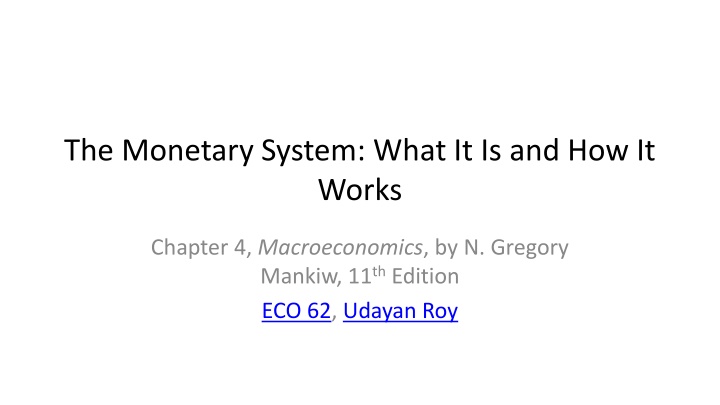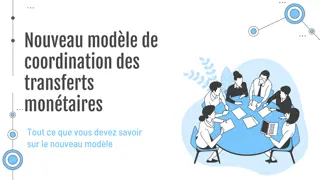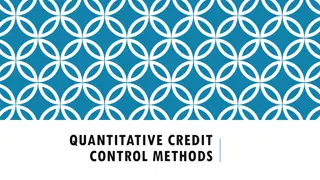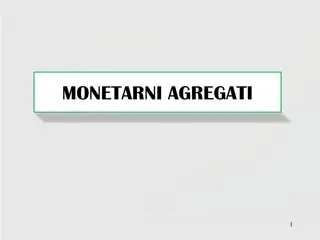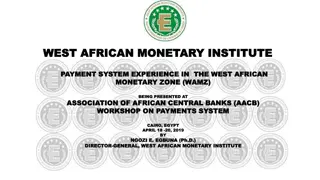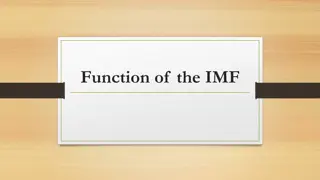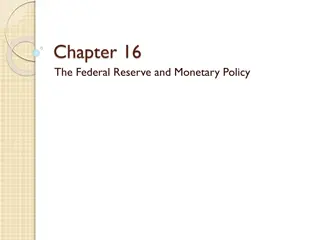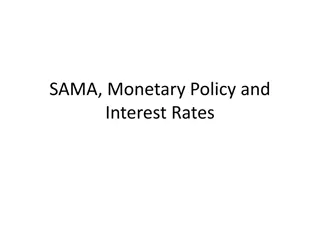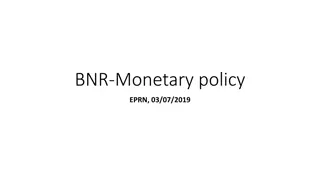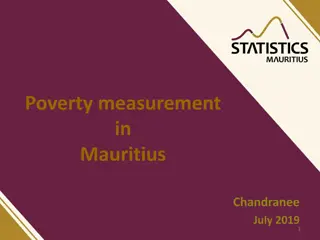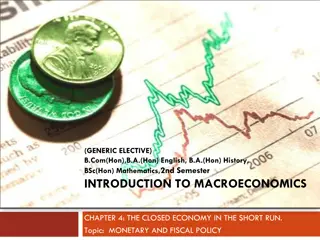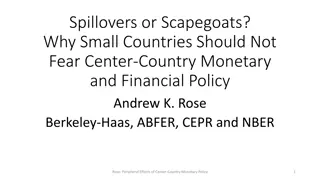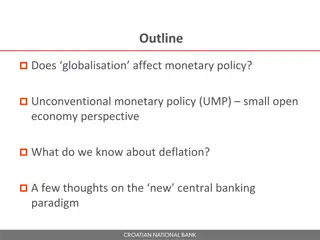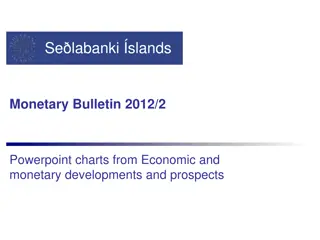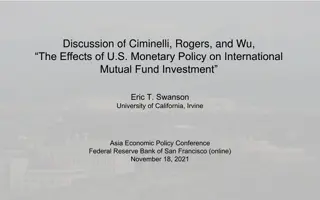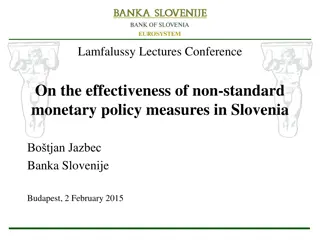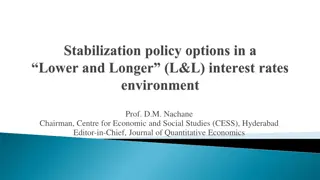Monetary System Overview
In this insightful overview, discover the essence of money, the significance of a nation's banking system in determining money quantity, and the influence of a central bank on the economy. Explore the concept of money, types of money, and measures of money quantity.
Download Presentation

Please find below an Image/Link to download the presentation.
The content on the website is provided AS IS for your information and personal use only. It may not be sold, licensed, or shared on other websites without obtaining consent from the author.If you encounter any issues during the download, it is possible that the publisher has removed the file from their server.
You are allowed to download the files provided on this website for personal or commercial use, subject to the condition that they are used lawfully. All files are the property of their respective owners.
The content on the website is provided AS IS for your information and personal use only. It may not be sold, licensed, or shared on other websites without obtaining consent from the author.
E N D
Presentation Transcript
The Monetary System: What It Is and How It Works Chapter 4, Macroeconomics, by N. Gregory Mankiw, 11thEdition ECO 62, Udayan Roy
Three Main Questions 1. What is money? 2. What is the role of a nation s banking system in determining the quantity of money in the economy? 3. How does a nation s central bank influence the banking system and the quantity of money?
What is money? Money is any asset that can be readily used to pay for purchases Therefore, money is a medium of exchange and a store of value Moreover, money also functions as a unit of account
Two Types of Money Fiat money People accept fiat money either because a government decree (or, fiat) requires them to do so or simply because others would also accept it as payment Commodity money This money is valuable in itself (e.g., gold coins) or can by law be converted into something valuable (as in a gold standard system)
The Quantity of Money The quantity of money, amount of money, and supply of money all refer to the same thing: The total value of all assets in the economy that can be used as money It is denoted M
Money: Definition Money is the stock of assets that can be readily used to make transactions. Two common measures of the quantity of money in an economy are M1 and M2
What Counts as Money? The dollar value of the currency we carry, C, should clearly be counted as money In the previous chapter, C represented consumption spending Take care to not get confused about the usage in this chapter Moreover, when we do our shopping, we use checks and debit cards exactly the way we use currency. Therefore, the dollars that we can spend this way should also be counted as money. Credit cards are ignored. Why?
The Quantity of Money There are several prominent measures of the quantity of money (M)
Table 4.1 The Measures of Money Simplified version: Money Supply (M) = Currency (C) + Demand Deposits (D)
Data Sources M1: http://research.stlouisfed.org/fred2/series/M1SL?cid=25 M1 and its components: http://research.stlouisfed.org/fred2/categories/25 Currency (C): http://research.stlouisfed.org/fred2/series/CURRSL?cid=25 Demand Deposits: http://research.stlouisfed.org/fred2/series/DEMDEPSL?cid=25 Traveler s Checks: http://research.stlouisfed.org/fred2/series/TVCKSSL?cid=25 Other Checkable Deposits: http://research.stlouisfed.org/fred2/series/OCDSL?cid=25
Data Sources M2: http://research.stlouisfed.org/fred2/series/M2SL?cid=29 M2 and its components: http://research.stlouisfed.org/fred2/categories/29 Retail money market mutual fund balances: http://research.stlouisfed.org/fred2/series/RMFNS?cid=29 Saving deposits: http://research.stlouisfed.org/fred2/series/SAVINGSL?cid=29 Small time deposits: http://research.stlouisfed.org/fred2/series/STDSL?cid=29
Banks Liabilities: how do banks get money? Banks take deposits (D) from depositors Banks also borrow money This is called their debt The owners of a bank must also invest their own money in their bank. This is called the bank s capital (or, equity) Total bank liabilities = deposits + debt Total bank funds = liabilities + capital
Banks Assets: what do banks do with their funds? Some of the banks funds are kept as reserves (R) Why? The banks depositors may need some of their money back But not all deposits have to be kept as reserves all the time If the arrival rate of new deposits is roughly equal to the departure rate of the money withdrawn by depositors, then some of the banks funds could be put to other uses
Banks Assets: what do banks do with their funds? Some of the banks funds are kept as reserves (R) The rest of the banks funds are used to make loans The interest charged on loans is a source of income for banks and to make securities purchases Banks earn income from the securities they own Total bank assets = reserves + loans + securities purchases
The Role of Banks in the Monetary System: Banks Balance Sheet The bank s funds its liabilities plus capital are used to buy assets Assets = liabilities + capital Liabilities and Owners Equity Assets Reserves $200 Deposits $750 Loans 500 Debt 200 Capital (owners equity) Securities 300 50
The Role of Banks in the Monetary System: Leverage Leverage is the use of borrowed money (deposits + debt) to supplement owners funds for purposes of investment Leverage ratio = assets/capital = $(200 + 500 + 300)/$50 = 20 Liabilities and Owners Equity Assets Reserves $200 Deposits $750 Loans 500 Debt 200 Capital (owners equity) Securities 300 50
The Role of Banks in the Monetary System: Leverage Being highly leveraged makes banks vulnerable. Example: Suppose the value of our bank s assets falls by 5%, to $950. Then, capital = assets liabilities = 950 950 = 0 (the end!) Liabilities and Owners Equity Assets Reserves $200 Deposits $750 Loans 500 Debt 200 Capital (owners equity) Securities 300 50
Capital Requirements To reduce the risk of a bank going bust as in the previous slide s example bank regulators impose capital requirements on banks The goal is to ensure that a bank s capital would exceed its liabilities, so that the bank s owners could return the money of its depositors and repay its debts Banks with riskier assets face higher capital requirements
Capital Requirements In the 2008-2009 financial crisis, losses on mortgages shrank bank capital, slowed lending, exacerbated the recession The government injected capital into banks to ease the crisis and encourage more lending
The Central Banks Influence A bank that prints currency is called a central bank Besides printing currency, central banks have other responsibilities such as regulating the behavior of financial institutions and keeping the economy stable We will now build an algebraic model of the central bank s influence on the monetary system of a country We will mainly discuss the central bank of the United States, which is called the Federal Reserve or simply the Fed
The Central Banks Influence Our first equation is one we have seen already: M = C + D That is, money supply equals currency held by the public plus bank deposits All three variables will be considered endogenous
Monetary Base The monetary base (B) is the total number of dollars held by the public as currency (C) or by banks as reserves (R) So, our second equation is B = C + R A country s monetary base is directly determined by its central bank B is exogenous; C and R are endogenous
Monetary Base = Currency + Reserves For December 2021, Monetary Base (B) = $ 6,413,300 million, Currency (C) = $2,225,300 million, and Reserves (R) = $6,413,300 million. Note that until the financial crisis of 2008, monetary base consisted almost entirely of currency. Since then, much of the increase in the monetary base has been in reserves.
The Currency-Deposit Ratio cd = C/Dis the currency-deposit ratio This is a matter of households preferences When people feel distrust of banks they may reduce their bank deposits (D ) and increase their currency holdings (C ) This increases the currency-deposit ratio (cd ) cd is assumed exogenous
The Reserve-Deposit Ratio rd = R/Dis the reserve-deposit ratio Note that 0 < rd < 1 This is a matter of banks preferences When banks are afraid to make loans or buy securities, they increase their idle reserves (R ) This increases the reserve-deposit ratio (rd ) rd is assumed exogenous
Demand Deposits ?? = ?/?implies ? = ?? ? ?? = ?/?implies ? = ?? ? ? = ? + ? = ?? ? + ?? ? = (?? + ??) ? 1 Therefore, ? = ??+?? ? We have expressed an endogenous variable, D, entirely in terms of our exogenous variables (cd, rd, and B)
Currency held by the public 1 We just saw that ? = ??+?? ? ?? ? = ?? ? = ??+?? ? Again, we have expressed an endogenous variable, C, entirely in terms of our exogenous variables (cd, rd, and B)
Reserves held by banks 1 We just saw that ? = ??+?? ? ?? ? = ?? ? = ??+?? ? Again, we have expressed an endogenous variable, R, entirely in terms of our exogenous variables (cd, rd, and B)
Money Supply We know that M = C + D. Therefore, ?? 1 ??+1 ??+?? ? ? = ??+?? ? + ??+?? ? = Again, we have expressed an endogenous variable, M, entirely in terms of our exogenous variables (cd, rd, and B)
The Money Multiplier ??+? ??+?? ? ? = The factor of proportionality is called the money multiplier: ??+? ??+?? ? = Therefore, ? = ? ? Note that, as 0 < rd < 1, it must be that m > 1 That is, for every dollar of monetary base created by the central bank, the money supply increases by more than a dollar
The Model Is Solved! 1 ? = ??+?? ? ?? ??+?? ? ?? ??+?? ? ??+1 ??+?? ? ??+1 ??+?? ? = ? = ? = ? =
Numerical Example Q: Suppose the monetary base is B = $800 billion, the reserve- deposit ratio is rd = 0.1, and the currency-deposit ratio is cd = 0.8. Calculate C, R, M, D, and m. A: R = $88.89 billion C = $711.11 billion D = $888.89 billion M = $1,600 billion, and m = 2
The Central Bank ??+? ??+?? ? ? = When the central bank increases the monetary base, the money supply increases When the reserve-deposit ratio decreases, the money supply increases When the currency-deposit ratio decreases, the money supply increases (Why?)
The Central Bank ??+? ??+?? ? ? = A country s central bank directly controls the monetary base, B, and indirectly controls the reserve-deposit ratio, rd. Therefore, the central bank can change a country s monetary supply And do so by directly controlling the monetary base or by indirectly controlling the reserve-deposit ratio
How does the Fed change the monetary base? Open-market operations: The Fed could print dollars and use them to buy securities (usually short-term Treasury bonds) from banks or from the public This reduces securities and increases reserves (R ) in the assets column of the banks balance sheets, and Increases cash held by the public (C ) Therefore, the monetary base increases (B = C + R ) whenever the central bank prints money and buys securities with it
How does the Fed change the monetary base? It does open-market operations: The Fed prints dollars and uses those dollars to buy securities (usually short-term Treasury bonds): from banks, or from the public When the Fed buys securities from banks (with the freshly printed cash), the banks stock of securities decreases and the banks reserves increases (R )
How does the Fed change the monetary base? It does open-market operations: The Fed prints dollars and uses those dollars to buy securities (usually short-term Treasury bonds): from banks, or from the public When the Fed buys securities from households (with freshly printed cash), the households stock of securities decreases and their currency holdings increases (C ) As R and C , B = C + R .
How does the Fed change the monetary base? When the Fed buys securities from a bank it is basically lending money to the bank These loans to banks increases banks reserves (R ) This typically happens when banks lose the trust of depositors and private lenders and are unable to borrow from them The Fed is then the lender of last resort The Fed s lending can take two forms: Discount Window Term Auction Facility
How does the Fed change the monetary base? Discount Window The Fed lends to banks directly and charges them an interest rate called the discount rate When the Fed reduces the discount rate, banks borrow more, their reserves rise by a bigger amount, and so the monetary base rises by a bigger amount
How does the Fed indirectly control the reserve- deposit ratio? We have seen that a decrease in the reserve-deposit ratio (rd ) causes the money multiplier and the money supply to increase The Fed influences banks reserve-deposit ratio by adjusting the interest it pays banks for the reserves the banks hold When the Fed reduces the interest rate it pays banks for the reserves they hold, banks keep fewer reserves and the reserve- deposit ratio decreases
How does the Fed indirectly control rd? By paying banks interest on the reserves they hold. This new monetary policy tool was a response to the financial crisis of 2008-9 US banks keep their reserves with the Fed The Fed now pays banks interest on the reserves they keep at the Fed A reduction in this interest, induces banks to keep fewer reserves This reducesrd, and increasesm, M, and B
Interest Rate on Reserve Balances See https://fred.stlouisfed.org/series/IORB. The interest rate on reserve balances (IORB rate) is the rate of interest that the Federal Reserve pays on balances maintained by or on behalf of eligible institutions in master accounts at Federal Reserve Banks. The interest rate is set by the Board of Governors, and it is an important tool of monetary policy.
Case Study: Quantitative Easing Prior to the financial crisis of 2008, the US monetary base rose gradually Between 2007 and 2011, it tripled, mainly through open- market operations The Fed printed money and used it to buy riskier securities than the Treasury bonds it buys during normal times
Case Study: Quantitative Easing Although the monetary base increased 400% during 2007-14, the money supply rose a lot less: M1 increased 100% and M2 increased 55% Why? ??+1 ??+?? ? and ? = Banks had suffered huge losses on their loans. As a result, they stopped lending. The reserve-deposit ratio rose, thereby reducing m This is why M did not rise as fast as B ??+1 ??+?? Recall that ? =
Case Study: Quantitative Easing But what if the rd returns to the pre-crisis level? Then the huge increase in B would translate into an equally huge increase in M This, as we shall see in Chapter 5, could cause massive inflation Should we be worried?
Case Study: Quantitative Easing No, there s nothing to worry, says the Fed They could simply sell the securities that they had earlier bought, thereby reducing the monetary base to pre-crisis levels Moreover, if there are signs that banks are beginning to lend the reserves they have accumulated, the Fed could raise the interest it pays on reserves, thereby reversing any decline in rd
